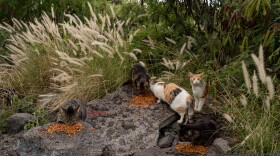Relocation has begun for some Puna residents forced from their homes by the Kilauea Eruption. Lava has been flowing on the Big Island for more than six weeks now, covering nearly 6,000 acres and destroying more than 500 homes. HPR Reporter Ku?uwehi Hiraishi has this story.
There’s no going back for an estimated 2,700 evacuees who have lost access to their homes since the eruption began in early May.

“Most recovery plans are based on the assumption that there is a rebuilding. You know, like if there’s a hurricane, you go in, you rebuild. You restore infrastructure, you rebuild damaged buildings,” says Kimo Alameda, “But in this case there?s nothing much to rebuild.”
Alameda works for the Hawai?i County Office of Aging. He helps lead a coalition of service providers both public and private sector in the disaster recovery effort.
“So we?re really looking at relocating,” says Alameda, “So the notion of relocation is something that...something that we kind of gotta create.”

And every idea is on the table. A hand-written flyer posted at the Pahoa Shelter reads “Free transportation to mainland available for you if you want to connect with family there. Contact Child and Familiy Services.”
“My name is Karen Tan, and I?m the President and CEO of Child and Family Service.”

The organization is offering evacuees free, one-way tickets to the neighbor islands and beyond.
“We try to you know identify those families that have the greatest need to relocate,” says Tan, “Perhaps they don?t have any connections on the Big Island or maybe no other family they can live with. Maybe no other options.”

The relocation opportunity is available to Hawai?i residents who have lost their homes or access to their homes and have someone at the final destination who will vouch for them.
“So we have had five families that we have actually helped to relocate to the mainland, and then we have six more that we’re in the process of helping,” says Tan, “So not a lot because not a lot of families want to leave completely from the state.”

For those who do want to stay, State Senator Russell Ruderman has a proposal. The Puna legislator is eyeing a 5,000-acre parcel of state land near Pahoa for a potential land swap.
“How it would work is we would take advantage of an existing state law that allows the state to provide land to people who have lost their land in a disaster,” says Sen. Ruderman.
Ruderman, who represents the Puna district and parts of Ka??, says this relocation mechanism is nothing new. It was implemented after the 1960 tsunami in Hilo and a couple of times since on O?ahu.

“The idea would be give up either your lot in the lava inundation area or the development rights to it for this newly developed plot,” says Sen. Ruderman.
The proposed land includes access to water and electricity and is otuside of Lava Zones 1 and 2.
“And my thought is if we can relocate people like this, we can keep people together as a community in a way that would be an example to the world of this is what you do in the face of a disaster,” says Sen. Ruderman, “You take care of people with compassion.”





